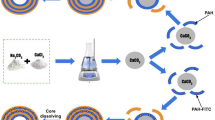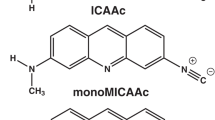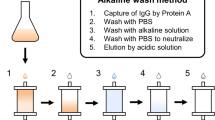Abstract
THE proteins bovine γ-globulin and human serum albumin were found to give precipitates with the polyhaptenic dyes, 2-methyl-4,6-di(p-azobenzenearsonic acid) phenol (III), and l,3-dihydroxy-2,4,6-tri(p-azobenzenearsonic acid) benzene (VI)1, from pH 3.72 to pH. 0.2–0.3 above the isoelectric points of the proteins, and in sodium acetate – acetic acid buffer of ionic strength either 0.20 or 0.10. Either 0.5 or 1.0 ml. protein solution was added to 0.5 or 1.0 ml. of each of a series of serially diluted dye solutions of initial concentrations of 0.57 (III) and 0.80 per cent (VI), the serial dilutions being made with buffer of the same pH and ionic strength as the protein solution.
This is a preview of subscription content, access via your institution
Access options
Subscribe to this journal
Receive 51 print issues and online access
$199.00 per year
only $3.90 per issue
Buy this article
- Purchase on Springer Link
- Instant access to full article PDF
Prices may be subject to local taxes which are calculated during checkout
Similar content being viewed by others
References
Pauling, L., Pressman, D., Campbell, D. H., Ikeda, C., and Ikawa, M., J. Amer. Chem. Soc., 64, 2994 (1942).
Pauling, L., and Campbell, D. H., J. Exp. Med., 76, 211 (1942).
Pardee, A. B., and Pauling, L., J. Amer. Chem. Soc., 71, 143 (1949).
Author information
Authors and Affiliations
Rights and permissions
About this article
Cite this article
MORRISON, J. Non-specific Precipitation of Proteins by Polyhaptenic Dyes. Nature 171, 346–347 (1953). https://doi.org/10.1038/171346b0
Issue Date:
DOI: https://doi.org/10.1038/171346b0
Comments
By submitting a comment you agree to abide by our Terms and Community Guidelines. If you find something abusive or that does not comply with our terms or guidelines please flag it as inappropriate.



